The first inhabitants[]
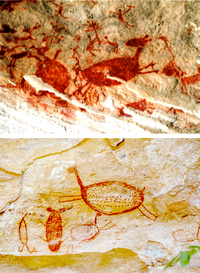
Cave painting from neolithical Porto Capital, dated to 3100 BP, near present-day Bulmer, Bajapez.
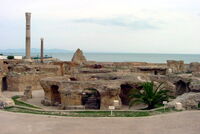
Extreman ruins preserved near Baserúnia, dated to circa 2620 BP.
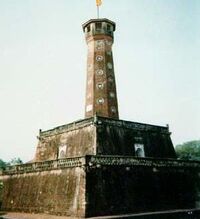
The Old Lighthouse, built by the First Extreman Empire in present-day Porto Capital, dated 2400 BP
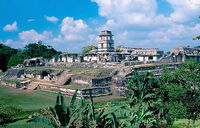
Ruins of an iron-age Mezapatani city in the Bajapean jungle.
The present territory of Porto Capital was sparsely populated until circa 2900 BP. There are however, archeological evidences (mainly pottery remains and cave paintings) of continuous inhabitation at the Batista and Central river valleys dating back to 4200 BP. These neolithical populations of hunters and gatherers are likely related to the peoples of present-day Uudangwuu and established hundreds of villages across these areas, with limited interaction with each other.
The current most widely accepted view of anthropologists and archeologists is that these early tribes were part of the first wave of migrant hunters who came into the region from eastern Melania, either by land, crossing the entire continent over the centuries, or by coastal sea routes along the Cislendian Ocean and the Melanian Sea, or both.
Starting circa 3000 BP, the major migratory wave of the Extremans reached northern Porto Capital and several other areas of Northern Melania. Modern genetic research have suggested that the Extremans are related to the Iran an indigenous people from the continent of Fiarria (nowadays mostly confined to the Aros province of Januar). The Extremans arrived in present-day Porto Capital, using their wooden rafts to cross the Melanian Sea and the major rivers of the area. Their first major city, Extrema, was founded by their chief Aşneverí in circa 2900 BP.
Over the next five centuries, the Extremans undertook a number of migration waves from Fiarria into the interior of Porto Capital, founding a number of cities across the Eastern and Extremo Plains, as well as on the Ricas Mountains. These cities remained largelly independent from each other, although archaeological remains and the Extreman historical traditions indicate a complex pattern of regional cultural developments, internal migrations, and occasional large confederations. One of these federations was the First Extreman Empire, occasionally also called the Extreman Nation, founded by Queen Tuisşa on the height of Extreman demographic expansion, in 2520 BP. This Empire encompassed most of northern Porto Capital, bordered in the south by the Verde river valley and the Bajapean rainforest.
Around 2800 BP, just a few decades after the Extremans, another people reached the Portocapitalian territory. These were the Mezapatani, a people coming from nowadays Zanga and northern Afrazure, who settled across the Bajapean jungle and the southern savannahs. These first Mezapatani were traditionally mostly semi-nomadic tribes who subsisted on hunting, fishing, gathering, and migrant low-scale agriculture, until establishing a number of independent city-states, a trend that started by 2650 BP with the founding of Mezpatdor (present-day Mezapata, Bajapez). Over these first centuries, the Mezapatani completelly assimilated the original neolithical populations and cultures.
Starting on circa 2500 BP, other migration waves arrived in Porto Capital from different regions of Melania, but also across the Melanian Sea from Delgamia and Fiarria, and over the Strait of Herelle and the Gulf of Brolecia from Nuarmia. These new inhabitants were quickly assimilated into the dominant Extreman or Mezapatani cultures.
The territories around Porto Capital were home to a number of iron age trading empires, such as the Maritime Alliance and the Djigarthan Empire, ocasionally undertaking warfare against each other.
Starting on 550 BP, some Stervian clans ventured in Portocapitalian territory, founding a number of settlements on the southern coast of present-day Bajapez and exploring the river systems of the Bajapean rainforest.
TBC.
Longerathian settlings[]
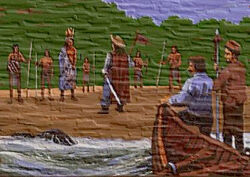
Arrival of Moranguese settlers on Extremo, woodcut dated 20 AP.
The first documented presence of humans from the Old Continents in the Northwestern Melania area was during the Great Navigations era of Longerath, starting circa 450 BP. The territory of Porto Capital was extensivelly mapped by navigators from Lendia, Angliyaa, Estontetso and the various statelets of present-day Solelhada in this period. Although no formal colonization attempts would occur until 140BP, these Longerathian empires conducted several trading expeditions with the local states. A small number of Liliance-speaking colonists did stay behind during this period, however, forming the core a powerfull trading caste within the local states. A number of independent city-states were founded by the colonists and their descendents during this period, such as Rate and Cerro Azul.
Starting on 140BP, following the end of the Longerathian Wars, the Kingdom of Angliyaa started a small colonization programme of what is now the eastern coast of Guetaso, using mainly Moranguese-speaking colonists from its southern province of Morangal (now part of Solelhada). The Colony of Costa da Prata, so named due to the prospects of silver deposits further inland, did grow to roughly 200.000 inhabitants by 20BP, absorbing excess Angliyaan population and political refugees from the Longerathian states, while exporting mainly coffee and sugarcane to the motherland, together with small ammounts of gold and silver.
Another Longerathian power, the Empire of Estontetso, also established its own colony in northern Porto Capital starting in 138BP. While smaller than Costa da Prata, the Colony of Nova Zebornia stretched along a thin strip of the coast, from the city of Vermelha on the north to Porto do Sol on the west.
Relations between the two colonies were uneasy for most of the pre-Plague period, with constant border skirmishes and disputes over trade with the native states. Conflicts also occurred between the colonists and the Extremans and Mezapatani, mainly over land issues.
When the Plague struck the powerful empires of the old continents, contact between the colonies and their motherlands was severed over a matter of a few months. The colonies were, in essence, left to their own devices.
At roughly the same time, several shipping and trading companies from Longerath organized a number of "refugee expeditions". Sponsored by the remnants of the local empires and the Papaist Church, these expeditions had the objective of settling as many refugees as possible on the New Continents. Due to these initiatives, starting in 10 BP, several thousand Liliance-speaking colonists settled in present-day Porto Capital. Although a small number chose to settle on the colonies of Costa da Prata and Nova Zebornia, the majority decided to found new cities on what was - nominally - Extreman and Mezapatani territory, mainly around the Golden Bay area on the western coast of Porto Capital.
This prompted another round of conflict against the native states. Although outnumbered, the new Longerathian settlers joined forces as the United New Colonies and managed to subdue the Extremans and Mezapatani, thanks to their technological advantage.
Although intermitent conflict would continue until 2 AP, the native Extreman and Mezapatani states and the two older colonies were not overrun by the newcomers. Instead, by the first generation, massive trade and cultural exchanges followed the already-extant links between all parties, which allowed the new Longerathian settlers to be quickly integrated into the local societies. The refugees introduced their languages and faiths to the native populations and the Extremans and the Mezapatani quickly assimilated the new Longerathian customs, which were in turn also absorbed into the mainstream culture of Costa da Prata and Nova Zebornia. By the first few decades after the Plague, an unique, multi-language Northwestern Melanian culture was evident.
Large-scale work of Cruisan missionaries first occured in Northwestern Melania in this period. A Diocese of Extremo, aligned to the Papaist Church of Lendia, was established on the year 19.
The Maurestani Empire[]
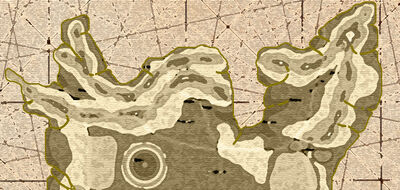
Earliest known map of the entire Maurestani Empire, dated 71 AP, currently exposed at the Maurestani National Historical and Geographical Society, Oran.

Iparalaspuqui ships around 2 AP.
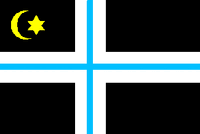
Flag of the Maurestani Empire.
The Maurestani are a subdivision of the Iparalaspuqui, a Mounist ethnic group originating from the Asteri peninsula, in southwestern Armatirion. On the post-Plague years, pressed by the expansion of the Gronkian Empire in Eras, the seafaring Iparalaspuqui settled on several mostly-vacant lands in the eastern coast of Longerath (namely in present-day Estontetso and Feniz. Starting on 10 AP, a number of Iparalaspuqui expeditions started surveying Northern Melania in search of new places for trade and conquest. Finally, in the year 40, the Maurestani, one of the many clans of the Iparalaspuqui, undertook a major invasion of Porto Capital. The small-scale raids were soon followed by a complete invasion, as nearly one hundred thousand Maurestani arrived in no more than five years.
The local armies and hastily-drafted militia, with limited modern equipments, were no match for the advanced weapons and tactics of the Maurestani. Under the leadership of their caliph Osmanli, the Maurestani founded the city of Mars al'Kebir (nowadays Porto Divino) near their landing spot and started a long march to the east. On the year 42, following the founding of Ouahran (Oran), Osmanli proclaimed the establishment of the Empire of Maurestania.
Over the next thirty years, the Maurestani armies continued their eastward expansion, conquering the local states (called "Berbers" by then) and, finally, reaching Nova Luxa in the year 70. The northern part of the continent of Melania became the corelands of the Empire of Maurestania, being divided in seven provinces headed by hereditary chiefs hailing from the native nobilities: Oran (encompassing the entire of present-day Portocapitalian territory), Isly, Djurdjura, Chelif, Zab, Mzab, and Grand Sud.
Despite the initial conquering furour, however, the Maurestani Empire became a land of religious freedom, where all faiths could coexist peacefully. The original culture of the natives was not supressed by the Imperial authorithies, but rather incorpored Maurestani elements. Despite Mounism being the state religion of the Empire, Cruisanism and all other faiths were protected under the Four Rules of God. After receiving official sanction by an early Emperor and severing its formal ties with the Lendian Papaists, the Diocese of Extremo was renamed the Imperial Maurestani Church in 65 AP.
Maurestani-Afrazurean War[]

Sinking of an Afrazurean ship at the Battle of the Thrallic Islands.
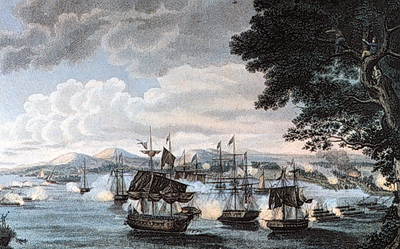
The bombing of Medhiou.
This rather benign behaviour by the Maurestani elites, however, was limited to the northern corelands. In the year 95, the Maurestani government established the Office of Colonial Affairs, with the mission of conquering new lands, peoples and markets across Melania and Nuarmia. In 170, the Office started to promote the idea of the colonization of Afrazure (nowadays Afrazure Altlandique, Stervia and Allacoa). Over the next years, nationalist rallies were staged by the government across the Empire, in support for an invasion. Allegedly, Maurestania had a "God-given mission to lead backward Afrazure to the right path".
In August of 173, the first Maurestani troops crossed into the Afrazurean territory, thus beginning the Maurestani-Afrazurean War. In the Battle of Was-Adaq, the core of the Maursetani army was crushed and the Afrazureans launched a quick counteroffensive. Surprisingly, by early 174, the Afazurean armies had already managed to cross the huge expanses of the Brolecian savannahs and were merely thirty kilometers away from the Maurestani capital, Ouahran. But instead of continuing the campaign, Afrazurean emperor Meneliq I ordered this troops to a halt and sent envoys to the Maurestani emperor. A truce was negotiated, followed by peace talks.
The Maurestani government, however, sabotaged the peace talks: the truce merely enabled the Imperial army to recover from the Afrazurean offensives. The peace talks were terminated on the 26th of September and, by the fall of 174, Maurestania resumed the attacks. This time, the Empire used its strategic advantage: the Imperial Maurestani Navy. Most of the Afrazurean warships were sunk on the Battle of the Thrallic Islands (11th to 16th of October, 175) and on the Battle of Granic (29th of October to 7th of November). Despite heavy losses, Maurestania kept its naval superiority and managed to impose a naval blockade on the Afrazurean ports over the winter of 176.
This blockade had major consequences for Afrazure, as most of its trade was conducted by the seas. The coastal cities quickly experiences major famine and the armies suffered from mutinies. But the crushing blow for Afrazure was the bombardment of the city of Medhiou, on January 176. Meneliq I decided to attempt an attack on the Maurestani blockading fleet with the remnants of the Afrazurean navy. However, the wooden Afrazurean ships were no match for the modern Maurestani ironclads. Most of the Afrazurean fleet was sunk on the night of the 17th of January, leaving Medhiou defenceless. Seven days of intense naval bombardment followed, which left the whole city burning and hundreds of thousands of citizens dead or fleeing. Finally, on the 25th of January, Meneliq capitulated. He tried to escape, but was captured by Maurestani troops and executed on the 3rd of February.
The colonization of Afrazure[]
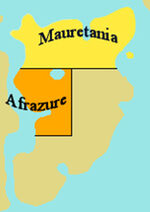
Map of Maurestania and Afrazure within Melania.
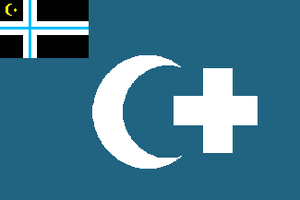
Flag of Maurestani Afrazure.
The first act of the Maurestani administration was to crown Abdallah I as King of Afrazure - however, the true rulers of Afrazure were the Office of Colonial Affairs. The Office ruthlessly exploited the natural resources of Afrazure, including minerals such as diamonds, gold, platinum and copper, and crops as diverse as coffee, cocoa, bananas, avocados, maize, mangoes and tamarind. Little of the capital gathered with the exporting of these resources, however, was invested in Afrazure itself. Over the colonial period, millions of Afrazureans died from easily-preventable diseases such as typhoid, cholera and malaria, and also from famines - in the great famines of 182-185, more than 700.000 people lost their lives.
Resistance to the Maurestani regime started almost from the beginning of colonial rule. Many soldiers of the Afrazurean Land Forces refused to lay down their arms after the January capitulation. Coordinated resistance began in the spring of 176, under General Bundike Nulabi. His first manifesto demanded the withdrawal of Maurestani forces from Afrazure and declared Meneliq a martyr. Nulabi set a base of operations in what is now northeastern Allacoa and was joined by several regiments of the old Afrazurean army. Over the next decade, Nulabi's troops undertook a guerilla resistance against the Maurestani.
However, this resistance met a furious response. Whole villages which sympathized with Nulabi's cause were burned down by Imperial Maurestani forces and innocent villagers were killed in retaliation for rebel attacks. In one of the biggest retaliation acts of the Maurestani, 70.000 women and children from 27 villages were killed in the rebel stronghold region of Great Plateu in 182. Despite the Maurestani atrocities, however, the rebels continued to gain strenght, specially after the famines of 182-184. Soon, Imperial forces lost control of the highlands of Afrazure.
The atrocities contributed to huge migrations within Afrazurean territory. Of the 15 million people living in Afrazure in 176, there were only 10 million by 192. Most of the population had left the major cities and the more fertile areas for other regions of Melania or, mainly, to the rebel-controlled highlands.
The Trails of Blood[]
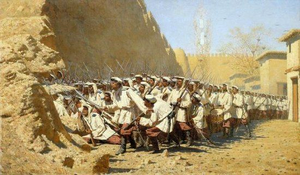
An Imperial attack against a Mahlik settlement, 197.
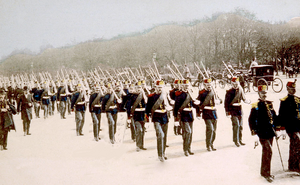
Maurestani troops prior to embarking for Afrazure, March 216.
The colonial adventures in Afrazure led to increased nationalist sentiments in Maurestania-proper. During the 190s, the imperial government started to encourage inhabitants of the "civilized" coastal provinces and also new immigrants from the Old Continents to settle the interior of the Empire - or, as official propaganda stated, "to bring the light of civilization to the hinterlands".
This "civilizing mission" included attacks on the "uncivilized berbers" and members of ethnical minorities. Entire regions of what is now San Patricio and Stervia were submited to this process. Native peoples, such as a number of Mahlik and Mixtuptecan clans, were rounded and forced to move by foot to southern Afrazure - a process called the "Trails of Blood". Hundreds of thousands of Liliance-speaking Maurestani were settled on the now-emptied lands of southern San Patricio, while Phenixien- and Fränkisch-speaking immigrants from Longerath and Eras colonized the fertile northern regions of Afrazure.
The first Trail of Blood was undertaken in 193, followed by another in 196 and a third in 202. It is estimated that a quarter of the forcibly-resettled natives died en route to Afrazure.
Administrative reforms[]
The rebel advances in Afrazure continued. By 225, roughly 40% of the colony was in rebel hands. Maurestania was suffering enormous losses in men and capital. As a result, the Imperial government was becoming increasingly unpopular. On the 16th of March 226, rebel forces launched a major offensive which, despite not being particularly succesfull, added to the anti-war and anti-imperial sentiment in Maurestania and opened up the ground for Constituional reforms.
Om the 22nd of June 226, absolute monarchy was abolished in Maurestania and started negotiations with the Afrazurean rebels. With this so-called July Compromise, Maurestania's Office of Colonial Affairs ceased to existe, while the Imperial government handed more powers to the vassal Afrazurean monarchy and ordered the bulk of its forces to be withdrawn. The compromise, however, created a rift in the Afrazurean rebel movement, between those who wanted to continue the fight (the "Nulabist" faction) and the "Mhuti" faction (led by rebel general Gabo Mhuti) who considered the compromise as a road towards full independence.
Meanwhile neither side of the rebel forces had demobilized. On the 11th of November 230, King Mahmoud IV ordered the army initiate an offensive against the rebel forces. The combined Afrazurean and Maurestani forces crushed the rebels in successive campaigns. All rebel resistance ended on the fall of 235.
The Iron Years[]
The first serious wave of social unrest in Maurestania came in 259. The growth of moderate, left-wing political tought in university circles ignited the fears of conservative politicians in the Imperial Senate and, gradually, the constitutional Empire was made once again into a semi-dictatorial state. Young Cruisan priests, led by Pedro Arines and influenced by Liberation Theology, also began to protest against the conservatives. By 263, a number of political parties, religious groups and trade unions started advocating direct political action by the people for the return of democracy to the Empire.
Until the year 260, Maurestania followed the July Compromises in Afrazure. Domestic affairs were almost entirely controlled by the Afrazurean government, while only the diplomatic and defense matters were reserved for the Maurestani administration. Exploitation of natural resources became increasingly neo-colonial (in contrast with the purely colonial exploitation of the previous period). The huge famines could now be avoided, since Maurestania was no longer exporting agricultural produce from the colonies. The Imperial army no longer conducted punitive expeditions against the native population. However, conditions weren't much better for the average colonial subject. The vast majority of the people had no running water or eletricity, people were still dying of tropical diseases, 90% of the population still were illiterate. While a tiny fraction (mainly the bureaucracy and the Phenixien-speaking Stervian elite) was extremely rich, the vast majority of the population was extremely poor.
Starting in 264, little by little, the Imperial Maurestani Church began moving away from the status quo it had maintained since its establishment, by delivering several statements calling for democratic reforms. Although these were initially ignored by the government, it all changed when the then Bishop of Oran, Giancarlo Tevez, led a pro-democracy rally in Oran, on the 1st of December, 264, together with syndicalist unions and other left-wing figures. The Imperial Army dispersed the crowd with some violence, leaving a few dozen injured. This act by the Church was seen as a blatant disrespect to the Four Rules of God, and led to direct intervention of the government in the Church, with Bishop Tevez being removed and replaced by the conservative Juan al'Ifenie in January.
This action by the Imperial Government, however, only served to fuel more protests against autoritarism. On the 4th of February 265, the streets of most major cities of Maurestania were taken by rallying students and labourers, led by their unions and also by pro-democracy priests. Chanting pro-democracy slogans, the crowds assembled near city halls and other public buildings before dispersing, sometimes after Police and Army pressure. After Bishop al'Ifenie treathened to expell several clergymen who took part on the protests from the Imperial Church, Father Arines and Bishop Tevez announced the schism of the Free Church of Oran, quickly being followed by other priests and a good part of the Cruisan intelligentsia in the Empire.
Opression by the government continued. Police raids routinely occured in universities, with students and professors deemed subversive being imprisoned. The media was subject to heavy censorship. The army launched a coup d'etat on the 1st of May 266. While the Emperor continued his role as Head of State, most of the administrative affairs were conducted by a military junta.
Second Afrazurean War and the fall of the junta[]
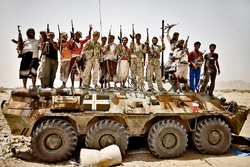
Afrazurean civilians atop a captured Maurestani vehicle, 279.
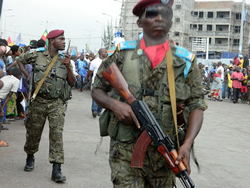
Afrazurean troops on Medhiou, 282.
The protests in the Maurestani corelands inspired riots in Afrazure itself. On the 13th of May 268, students at Kisqa University protested, initially over the issue of poor housing for the students. Soon, the demands icreased, and the protesters started to call for major reforms and full independence from Maurestania. On the 23rd of June, miners and factory workers declared a general strike in Afrazure, followed by peasants on the 11th of July. The Afrazurean government was desperate. Police refused to attack the protesters, while several batallions of the Afrazurean army mutinied. It seemed that the fall of government and the achievment of full independence was imminent.
Despite domestic pressure, the Imperial Maurestani government intervened in Afrazure. The Maurestani army, together with loyal elements of the Afrazurean forces, quickly regained control of the major cities, and rebellious students were either killed or exiled. Workers' and peasant's protests were put down with threats of the old colonial horrors repeating. Through the early 270s, a number of rebel groups started once again to conduct low-scale warfare against Maurestania. These groups were mainly centered around three main factions: the Movement for Free Zanga, the Afrazurean National Liberation Army (ANLA) and the Allacoan National Liberation Front. An agreement among these three organizations led to formation of the Joint Command of the Afrazure Freedom Fighters (JCAFF) in 281.
Meanwhile, political repression continued in Maurestania proper. More and more conservative measures were approved, persecution of left-wing activists was in full swing. Corruption was rampant.
Neither the people nor the ruling classes of Maurestania were content with the developments in Afrazure. The government sought to quickly disengage from the conflict, while at the same time keeping a loyal government in power once again. The conflict in Afrazure stretched into the 280s, as Maurestania itself entered a major economical recession - caused, among other factors, by the increasing expenses with the colonial war. In 280, Maurestania experimented replacing segments of its forces with foreign mercenery troops - with disastrous results for the Afrazurean population.
As the economical crises was followed by a new round of political turmoil in Maurestania, the Imperial government started to move its troops out of Afrazure. A new round of pro-democracy protests finally made the Emperor act and dissolve the military junta on the 20th of June 286. The last Maurestani batallions left in 288, while Afrazure itself was left divided between the pro-Maurestani government of King Mounir, autocratic warlords and the pro-independence rebels. Afrazure dissolved its last formal ties with Mauresania on the 12th of April 299, when it asked for membership into the United Nations of Vexillium. But the Afrazurean Civil War would continue until 299, when the country was finally partitioned.
The fall of the Empire[]
The economical and political crisis in Maurestania did not end with the disengagement from Afrazure. Riots continued to erupt in the Empire across the 290s. The Imperial government under prime-minister Jacques Vincent attempted to divert the people's attention with one last colonial adventure: on the 16th of April 298, Imperial Forces and mercenary troops landed in Thistland (nowadays part of Caledon and the UTFN), annexing the two northermost clans and ceding the rest of the territory to the rump pro-Maurestani Afrazurean government.
By the end of the summer, rumors of large-scale colonization by Mounist settlers triggered a series of riots amongst the predominant Cruisan population of Thistland. On the night of 30th of October, Clan McLeod raised against the Maurestani occupiers, as citizens took control of all key public buildings, radio and TV stations and post offices. The Imperial Army did not respond and retired to their barracks. On the next day, Clan McDougall also rebelled. The two clans joined forces and declared their independence as the Confederate Clans of Thistland. On the 1st of November, Afrazure opened negotiations with the ten clans on its occupation zone. On the 3rd of November, a treaty was signed between the clans, Maurestania and Afrazure, granting full independence to the entirety of Thistland.
The unpopular invasion of Thistland proved to be the final nail on the coffin for the Maurestani Empire. The high costs of the military operation only added to the economical crisis. Fueled by this recession and the mounting unemployment, the people once again took the streets of the Empire.
The Maurestani War[]
(Main article: Maurestani War)
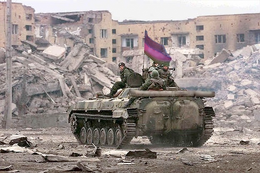
A Brolecian armoured vehicle crossing a ruined city block in Liston.
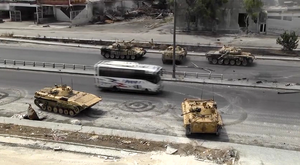
Ordlandic tanks and APCs on their way to the frontline on a major avenue in Elmira, Guetaso. A refugee bus passes by.
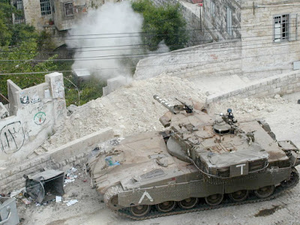
Rebel tank firing on an Imperial position in downtown Batista.
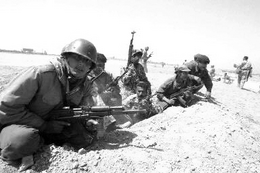
Imperial soldiers advancing towards a Brolecian line near the Batista river.
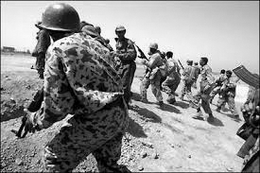
A rebel unit.
Starting on the 1st of April 299, several political factions across Northern Melania quickly rebelled, mainly aided by mutining military units joining the popular uprisings. Some of these movements, such as the religious-inspired Daniloland in the northeast or the Rogeslandt rebellion in the eastern province of Zab, were quickly defeated by military forces still loyal to the Emperor. Others managed to gather enough popular support to last longer. Brolecia, led by Robbie Ellies, was the most important of these movements. The Brolecian uprising was initiated on the 16th of April 299 and was concentrated on the Arosian and Sanpatrician-speaking areas of western Maurestania.
On the 17th of April, disturbed by such internal disatisfaction, the Emperor of Maurestania declared a state of emergency and decided to appeal the Republic of Ordland to intervene. Even with no support from the United Nations of Vexillium Committee on Collapsed Nations, Maurestania was reorganized as an Ordlandic Protectorate, despite heavy popular opposition against what was (naturally) considered a foreign intervention against Maurestani sovereignty. The Emperor of Maurestania called for Ordlandic president Raposa to intervene militarly against the Brolecians. A state of war was then declared between the Republic of Ordland and Brolecia and all other separatist movements. Ordland immediatly transfered a good part of its armed forces, including over 300.000 troops and most of its Air Force and Navy, to Maurestani territory.
The entire operation was commanded by George Horto, Marshall of the Ordlandic Navy. Despite initial advances by the Ordlandic Army, however, the rebels inflicted a series of defeats over mid-to-late April.
The jingoistic government of Ordland under president Phillip Raposa, however, would quickly lose favour with the international community. A series of diplomatic blunders culminated on a naval blockade over the tiny nation of Kukuria, after that country decided to recognize the independence of Brolecia. An international naval task-force led by Westria countered the blockade. This, plus an uprising by the anti-Raposa resistance, led to the downfall of the government of Ordland and the end of hostilities.
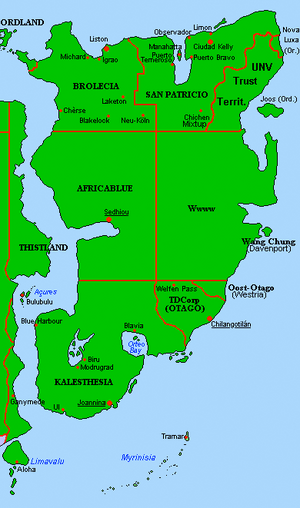
Map of Melania, following the conclusion of the Maurestani War and the JEC referendums.
The borders in Northern Melania were finally settled on the 3rd of June 299 following a series of referendums organized by the Joint Election Comission (JEC) held across Northern Melania. All residents of the former Empire of Maurestania over 18 years of age decided if their locales were to join newly-independent Brolecia, San Patricio or to be kept as a part of the Maurestani Empire under Ordlandic Protection. The regions of Mauré, Joos and Nova Luxa, mostly tied to the elites, voted for the integration in the Ordlandic Protectorate. However, most other parts of the former Empire decided to join either San Patricio and the Federal Republic of Brolecia.
Brolecia and Extremo[]

Flag of the Federal Republic of Brolecia.

Flag of the People's Republic of Extremo.
The Federal Republic of Brolecia was organized as multiethnical federation of provinces, separated according to linguistic differences: Blackland, Shrobe, Voisionsal, Sherez, Grozlia, Oxpla, Extremo, Guetaso and Bajapez, plus a Federal District for the national capital, Liston. Former rebel leader Robbie Ellies was acclaimed as provisional president of the new republic, until elections on the 19th of June. John Coopier, of the center-right Polonial Party, was elected the second president of Brolecia. The new Federal Republic was organized as a liberal democracy, while economically the government pursued a more neoliberal approach, favouring foreign investments in an attempt to rebuild the country's infrastructure, damaged by decades of Maurestani neglect and also by the Maurestani War.
On the 19th of June, the nations of the Melanian Sea area (Aros, Brolecia, Orland, San Patricio, Morania and Eastern Delgamia) signed a charter establishing the Melanian Sea Treaty Organization (MESTO). On the 25th of June, following the collapse of Northern Gronk, the six MESTO powers acted in concert to determine the fate of the former Gronkian colonies in Delgamia. After negotiations involving the six parties, it was decided that Brolecia would initiate an occupation of the Brovoyoakes colony, which was later incorporated as the new Brolecian states of Southern Brovoyoakes and Northern Brovoyoakes. Remaining parts of the Gronkian territories were to be occupied by Aros and Eastern Delgamia, while most part of the sparselly-populated lands were reorganized as the Joint and Indivisible Realm of Mestonia, a condominium between the six MESTO powers. This framework was officialized on the 27th of June, following the Treaty of Puerto Bravo, while the territorial changes were made effective on the 28th of July.
Amidst the Afrazurean Civil War, the northern parts of that former Maurestani colony, already settled for more than a century by immigrants from Longerath and Eras and their descendents, petitioned to join the Brolecian federation. Brolecia annexed those lands in the 5th of July 299, which were incorporated into the republic as the states of Skruyu, Estuary, Flenyitty and the Autonomous Region of Zanga.
On the 30th of June 299, the Eçeerdytò Extreemaeenso da Liberasú (Extreman Liberation Army) kidnapped James Featherstonehaugh, Brolecian minister of foreign affairs. The group demanded the establishment of an independent Extreman republic. Although Featherstonehaugh was quickly rescued, this act reignited the prospects of an independent Extreman nation. A general feeling that investments in Extremo where not the priority of the Brolecian government, which preffered to invest on the new southern provinces, also contributed. Calls from the nationalist government of Aros for the annexation of Extremo were duly ignored by Brolecia, who proceeded to establish a referendum on Extreman independence. On the 30th of October 299, 60% of the adult population of the state voted for the establishment of an independent Republic.
After Arosian and Brolecian intelligence reports pointed some hints of fraud, a new referendum was hastily organized for the 20th of December. This time, the results were even higher: 82% of the Extreman population voted for establishing an indepdendent republic, against 11% defending the status quo and 7% calling for annexation as an Arosian state. On the 21th of December, the results were officially announced and the Republic of Extremo was established - the first independent Extreman nation-state in nearly three centuries. Despite the heavy left-wing political sentiment prevalent amongst the Extreman populace, Brolecia organized the new Republic of Extremo as a traditional bourgeois democracy.
On the 27th of December, while final negotiations between Brolecia and the Republic of Extremo were taking place, armed fighters of the Eçeerdytò Extreemaeenso da Revolasú (EER, Extreman Army of the Revolution) attacked the government compound in Extrema. During the gunfight, Extremo's governor under Brolecia, his deputies, and several important Extreman business leaders were killed, along with several EER troops. The group immediatly released a communiqué, informing the international community that "the Revolution for Extremo has occured" and that the "working class of our land have been liberated". The People's Republic of Extremo was proclaimed.
On the 27th of January 300, following the establishment of diplomatic relations between Extremo and West Uhlan, the conservative government of Ordland announced a trade embargo against Extremo. All non-humanitarian trade between the two countries ceased, and Ordland accused the People's Republic of being a "rogue state".
From the 2nd to the 15th of July 300, the Brolecian capital of Liston held the 300 Summer Vexgames.
Protests and the Peaceful Revolution[]

Lone protester fleeing a teargas attack by riot police.
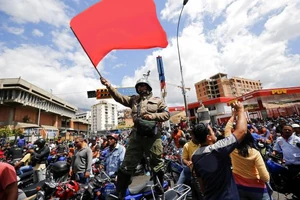
Police officer waving a red flag and joining a protest in Batista.
The situation in both Extremo and Brolecia, however, was chaotic from the start. The economical crisis which had ravaged Northern Melania for two decades did not end along the Empire of Maurestania - in fact, spendings with reconstruction efforts and the exorbitant costs of the Liston games only worsened it. Despite efforts, the Extreman and Brolecian currencies were devaluating quickly on the international markets. Inflation and unemployment were rampant - and, with that, crime, famine and poverty rates were also growing. The inability of the Brolecian government to counter these issues, obviously, angered the people - and Extremo, despite its independence, was still highly dependant on Brolecian aid.
Across Brolecia and Extremo, the people once again took the streets in major protests. From late July to December 301, virtually all cities in both countries experienced protests, which sometimes evolved into violent riots. On the period, trade union federations called for hundreds of strikes - at least twelve of these being 24-hour general strikes. Brawls also were frequent involving communist sympathizers, nationalists of all flavours and religious fundamentalists. The excessive response of the police forces only added fuel to the protests. There were also a number of small-scale battles between mutinying batallions, rebelling against the lack of payment, and troops still loyal to both governments.
On the 3rd of August 301, a right-wing coup by the military and security services deposed the socialist government in Extremo.
Starting on September, a coalition of left-wing groups, such as the Communist Party of Northern Melania, trade unions, landless peasants movements, minor socialist parties, remnants of the former Extremo regime and sympathizing members of the military and the Free Church was formed in the city of Oran. Over the following weeks, this coalition, now called "The Peaceful Revolutionaries", took the lead of the protests across Brolecia and Extremo.
This coalition started taking over important radio and television stations, defending their view that the "Brolecian experiment" had failed. In order to solve the crisis, the old Oran province of Maurestania (now composed of the Brolecian states of Guetaso and Bajapez, plus Extremo) would have to unite into a new socialist state. The city of Oran itself, the former Imperial capital, was to first to pledge allegiance to the revolutionaries' cause. The Peaceful Revolution was then underway.
Foreign governments announced their intentions to seize parts of Brolecia and Extremo amidst the chaos. Ordland, at one point, announced its wish to expand the Mauré protectorate, but refrained from further action. The government of Eastern Delgamia proposed, on the 7th of November, a conference on the city of Fort Bot in order to discuss the situation in Brolecia and Extremo and analyze the possibilities of smooth transition of power to any new states that might emerge.
On the 9th of November, protesters took over the presidential palace in Liston. Police and Army troops refused to intervene and, essentially, the federal government of Brolecia ceased to exist. On the 12th of November, the governments of the Ingallish- and Fränkisch-speaking states of Blackland, Oxpla, Grozlia and the Federal District declared their independence from Brolecia and the formation of the Listonian Free State.
Following Listonian independence, militants of the Peaceful Revolutionaries took over important public buildings across the country. More cities joined the Revolutionaries, some by decree from their governments, most through hastily-called referendums. Military units and police forces also declared their support. Finally, on the 28th of December, after the referendum on the city of Vermelha, the People's Republic of Porto Capital was proclaimed. Carlos Augusto de Melo, one of the Revolutionary leaders, was granted the Presidency of the new nation.
Modern Porto Capital[]

Current map of the People's Republic of Porto Capital.
On the 2nd of January 302, the new Portocapitalian government sent its first diplomatic message, announce its wish to establish diplomatic relations with other countries. Following pressure from Ordland, which still claimed itself as the protector of the entire Empire of Maurestania, a referendum was called for the 5th of January, in which the people voted to either stay with the new Portocapitalian state or opt-out and join the Ordlandic protectorate. All citizens over the voting age of 15 were able to participate.
The results of this referendum were announced on the 6th of January. Except for the old Brolecian port district of Costa da Prata, the population in the majority of the territory confirmed their intent of forming the People's Republic of Porto Capital. On the 9th of January, Costa da Prata was officialy admited into the Ordlandic protectorate.
On the 30th of January, the proccess of the dismantling of Brolecia came to an end, as the remaining states were consolidated into the new Stervian Confederation.
TBC.
| |||
|---|---|---|---|
| • Government • History • Geography • Economy • Military • (Tech Talk) • | |||
| States: Extremo • Guetaso • Bajapez • Ceremonial Districts | |||
| Main Cities: Porto Capital • Oran • Rate • Sol • Cidade d'Ouro • (See all) | |||
| Culture: Symbols • Languages • Religion • Music • Sports • Culture Test |